

As tensions continue to ease between the United States and Cuban governments, mixed martial arts (MMA) promotion companies in the U.S are eagerly beginning to build ties with Cuban fighters. In 1962 boxing was banned on the island nation, as it was deemed corrupt and unsafe. Since then, amateur boxing and mixed martial arts fighting have become exceedingly popular and successful through underground fighting.
In a drained Olympic size swimming pool, Roniel Michallena, a five time MMA national champion trains a group of next generation fighters in the heart Havana. “My favorite part is working out here in the street and practicing technical moves,” he said. Despite the makeshift facility and lack of proper training resources, Michallena and his students work long hours at improving their skills.
Regardless of their do-it-yourself training methods, Michallena believes that hard work will pay off. “If we want a future and if we want to be big, this is a good way to be well known,” he said. “With my heart I tell you this.” MMA promotion companies are looking to not only recruit Cuban fighters, but also to introduce their broadcast networks to the island. It will be interesting to see whether or not this transnational relationship continues to grow. Meanwhile, Michallena and his students patiently await their chance to prove themselves.
- Garrett Guinn
Tonight ended on the highest note possible. It still doesn't even feel real. The entire day was filled with activities, but it was the night that was unbelievable. 500 words isn't enough to describe it. I'll have to be brief: it is March 27th and today we are heading to Varadero, one of the highlight vacation spots in Cuba. With a GoPro attached to the front of the bus, the team moves out.
Our first stop, the Matanzas province, with tours around a publishing house, an art gallery, and a church. While on the bus, I realize that I'm drifting. I feel torn between a long nap or three hours of viewing Cuba's landscapes. It's an obvious choice. Nap time it is. Sleep is undeniable.
Those three hours went by in an instant. We were in Matanzas, parked right outside of the publishing house. Books are handmade here and are gorgeously bound. We even get to see the process while we're told about the store. However, I meander myself outside to do some exploring of my own. With camera in hand, I walk down to shoot a nearby river. The group quickly finishes and we head to the art studio. I stay outside during the tour, but make my way into the shop when the crowds die down. There is definitely a focus on sculpture, and, of course, the cat mug I see would make an excellent gift. Next on the list is Varadero, but before we leave, we tour a famous church, dance with some locals, and witness a spectacular view.
Earlier, I was told that in Varadero, most Cubans are not allowed. I found this to be very true. It is touristy. All of the shops have the same fake trinkets, and most of the people walking around are not locals. Culturally, this place is my least favorite, but my-oh-my is the beach nice. I've never seen water so blue and clear; small fish can clearly be seen swimming up to your feet. Hours were spent in those waters, and after dinner we smoked cigars in the setting sun.
The night promised much. It was our only night full of free time. It started with a game called Mafia on the beach, but the end of the night was the real highlight. We found an outdoor restaurant that played live Cuban music. Varadero may not feel authentic, but that restaurant sure did. My life was at a high, when a hurricane-like storm caused a blackout. So what did I do? Yelled with delight and sprinted outside to dance in the rain. Many others quickly followed. Not only those from U of O, but people from all over the world were out enjoying the warm rainfall and Cuban music. I know it sounds cliche, but it was one of the best moments of my life. Unforgettable to say the least. My time in Cuba has been amazing, but, dare I say, that this night in Varadero has been the best.
-Andrew Spangler
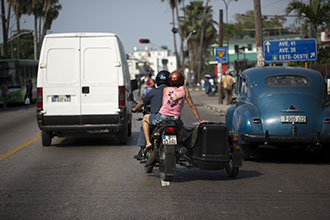
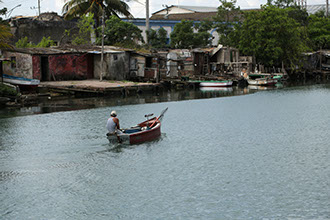
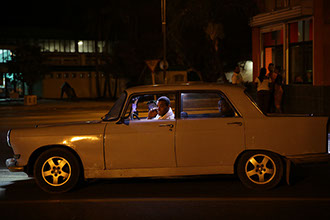
Upon our arrival in Cuba, we sat down with Reverend Raul Suarez Ramos, a member of the National Assembly of the People’s Power, who told us, “Havana is not Cuba.” He made the comparison to how New York City is not an accurate representation of the United States. After spending three enchanting days in Havana with a group of more than twenty student journalists, I was eager to explore outside the city.
Impatient to discover the more rural parts of the island nation, to find the real Cuba, I was excited on the fourth day when we set out for San Antonio de los Banos, a municipality forty-nine kilometers southwest of Havana in the Artemisa Province. The hour-long bus ride offered a vivid and surreal look at rural and agricultural life for Cubans. Propaganda billboards endorsing the Castro regime and the victory of the “invincible revolution” spotted the shoulder of the road. Two old men rode a horse and buggy along the highway. Workers in the fields herded cattle and picked crops.
Occasionally we saw military personnel hitchhiking along the side of the road. Every three to four kilometers, pairs of giant metal roadblocks were stationed on the side of the highway, ready to be used to deter enemy air landings in case of war.
Our first stop was the International School of Cinema, which was far more advanced than I would’ve expected, considering Cuba’s current economic situation. Modern editing rooms where students were using Final Cut Pro 7, a broadcast studio, music studios and spacious dorms crushed my expectations. In the graffiti-covered walls of the common area, signatures of both Francis Ford Coppola and Steven Spielberg could be found. The cinephile in me geeked out.
For lunch we drove out even further into the Cuban countryside to a local eco-friendly farm, where we were treated to a full course meal. Even though it was a basic meal of rice, beans, potatoes and chicken, it was undeniably fresher and more natural than anything I had ever savored back in the States. For the first time in days, there were no bustling cars, trucks or motorcycles, no barking dogs or people shouting. Small yet expansive palm trees provided ample shade from the beating sun. It was quiet. I sat and enjoyed my food and the serenity.
Now that we have returned to the States, I know that I still have more to see. Immersed in the city life of Havana, I found that despite the poverty, Cubans exude a fiery culture and life, and the strongest sense of community I have ever seen. The same sense of community was found once the bustle of the city fell away. However, this was obviously a very structured trip, and our perception of the nation as student journalists was guided towards a positive light. I know that there’s a lot more for me to see and discover in Cuba. Speaking to Anthropologist Elias Aseff, he said, “Enjoy my country. But do not try to understand it.” Challenge Accepted. I look forward to my return.
- Garrett Guinn
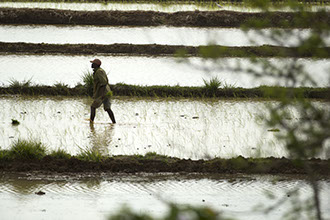
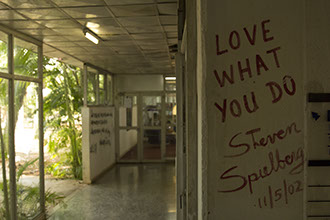

What does a rooster, a fork, a pair of high heels, a naked woman and two Americans all have in common? Surprisingly, not a lot, but it did create an adventure that Kevin and I would remember for the rest of our time in Cuba.
Kevin and I were doing some structured exploration on our afternoon off in old Havana when we stumbled upon a square called La Plaza Vieja. This square looked like every other square in Havana, it was filled with tourists, people taking photos, colorful buildings and schoolchildren playing red rover. But there was one thing that caught our eye in the far corner of the square that was definitely out of the ordinary.
Standing before us was a giant bronze sculpture of a naked woman only wearing high heel shoes sitting on top of a rooster carrying a giant fork.
I honestly had never seen a sculpture like this before, let alone expect to see something somewhat controversial like this displayed in a public square in Havana, Cuba. We desperately searched for the artist’s credentials by this mesmerizing sculpture but we couldn’t find anything. Kevin and I desperately wished we had access to the Internet to discover who was behind this beautiful creation. We took a few photos of the naked woman and the rooster and headed back to the rest of the group with stories and evidence of this amazing piece of artwork
A few days later we were on our way to Varadero, Cuba for a day of fun on the beach. Before we made it to Varadero we stopped in Matanzas, Cuba to see a handmade book publishing and production house. After the book publishing house tour we walked into a studio called Galeria Taller. Immediately I was overwhelmed from the large bronze statues that were towering over me. Each statue was very unique but they also shared some common themes surrounding in elements of poverty, nudity, and random household items. One statue was being packaged to go to a private buyer in San Francisco and even though I had never seen the statue before something was extremely familiar about it. I couldn’t figure out what was so familiar about the statue until I looked around the studio and noticed the use of pots and pans in some of the work. Suddenly it hit me and I turned to Kevin, “Kevin, THIS IS IT! This is the same sculptor who did the piece of the woman and the rooster in Havana!”
Suddenly everything seemed to fall into place, we were standing in the studio where the statue of the rooster and the naked women was created. We met the artist behind the sculpture; his name is Osmany Betancourt Falcon or “Lolo”. It was a surreal feeling knowing that “fate” or some other force brought Kevin and I to this studio. I mean, it was scheduled in our itinerary so Kevin and I didn’t really have a choice in whether or not we were going to go to the studio, but it sounds more mysterious if you believe that the rooster woman brought Kevin and I to Lolo's studio. So that’s the story about how two American students, a rooster, a fork, a pair of high heels and a naked women all go together.
- Kelly Wolfram
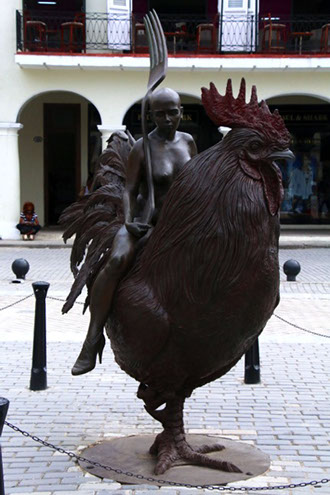
We waited for hours to check into our flight back to Miami and watched as Cubans with a friend at the counter cut the line over and over again. Moving inches at a time among people anxious to proceed, I felt content. For me, this meant more time to be around the individuals who inspired me all week, but this elation was not a universal feeling for the group.
Departing from Cuba, emotions were scattered. There were inevitable feelings of nostalgia for leaving this beautiful place and breaking apart from the group. There also seemed to be mixed emotions for returning home and fears of what awaits stateside. Some people will be starting new jobs this week and many will be graduating in three months without a plan. Some will pull up to their homes greeted by a family and a few are well on their way, with marriages this year. Others are about to face emotions they don't quite understand after a week in limbo—in paradise.
I didn't know any of these details 10 days ago. I entered the group as the youngest without ever working with most of these people. Through bus ride conversations, walks along the decayed and colorful streets of old Havana and explorations of our neighborhood in Marianao, I slowly became acquainted with the passion and talent surrounding me—with the thoughts and fears of those who have seen and done more than I have.
There is something much more candid about connecting without people in an informal setting. One in which we are all brought to the same level. We discovered common interests, schemed about future travel, compared middle school lows and debated life. The amount I learned from simply listening was endless.
Back in Miami, with a night before we all jet off in different directions, there was a sense of separation anxiety as everyone moved into their separate hotel rooms. “What do we do now?” The solution was to cram into one room to look at photos and reflect together one last time.
I return from Cuba bearing photos, cigars and some smelly clothes. Those are the tangible takeaways. But more important are the moments of emotion, revelation, insight and bonding, which I can only access in my memories.
So, to those who heard “Cuba” and thought “Why not?”
To those who made it a reality.
To those who initiated conversations and games.
To those dedicated to their craft and to helping others understand it.
To those who danced in the rain and snuck onto rooftops.
To those willing to expose themselves and be raw with one another.
Thank you for being a part of my adventure and for the positive impact you have made on me. I can’t wait to see where you will go.
- Kyle Hentschel
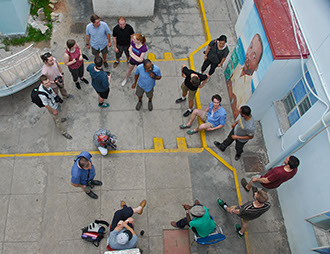
Today was not what I expected. Although in all fairness, there were many surprises on this trip but this day was different. We had spent yesterday breaking the ice with bassist Mariel Rivas and her family by doing our formal interview with her at our house. Because of the tight space the interview was conducted in, I was not present during the interview so I felt somewhat at a disadvantage as we headed out to meet her at her performance late last night. We hadn’t really had a chance to get to know each other but somehow in my gut I knew it wouldn’t matter. As a musician, I already felt a connection with her because of our shared love of music.
My day really started late last night when the band Mariel plays in, the David Blanco Band, took the stage at 11 p.m. I was prepared to film and take photos. All of my gear was ready. Fahmo and I had staked out the venue and we were set up in a great shooting location at the front of the stage. I was prepared in every sense both mentally and technically. This is what I love doing. This is why I love journalism. I love capturing artists at work. It feels as if I’m sharing their experience with them in the moment and it’s such a natural high for me. I had no idea what was to come over the next few hours. It was beyond anything I could have imagined. I didn’t just get to shoot a concert. I got to spend the early hours of today shooting an experience.
I knew the band Mariel played in was good and I knew I would love the performance but I didn’t know it would be the highlight of my trip. The odds of being able to see her perform with the band at all while we were in Cuba were very slim but then to have a private party performance scheduled for one of the two days we had to spend with her still feels miraculous to me. I’ve been to several rock concerts and felt the energy and spirit of those performances for days afterwards but this time it was different. The soul and emotion I felt from those musicians is nothing I’ve ever felt before. I expected to hear amazing music in Cuba but I didn’t expect to see so much spirit and passion behind it. This wasn’t a job for them. It wasn’t work. They loved performing and it showed. The performance wasn’t good because it was mechanically or technically precise. It was great because it was full of life and the spirit of Cuba.
Even though I was physically in the country, I think I finally arrived in Cuba during that performance. The performers and the audience became one unit and celebrated together. There was no us or them and even with a language barrier and a camera in front of me, the performers and the fans included me in their experience. There were many times that they embraced me being there and included me in their dancing and singing. I didn’t understand most of what was sung or spoken that night but it didn’t matter. I felt part of something bigger. I felt like I was a part of Cuba, like I belonged, and if only for a few hours, I felt Cuban. I don’t think you can ever unfeel that.
- Pam Cressall
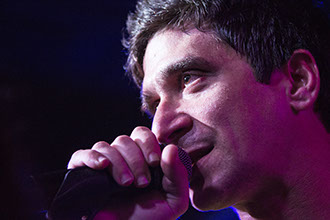
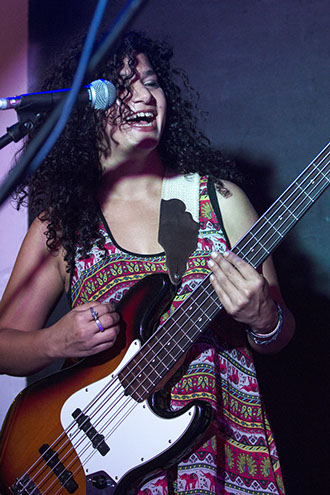
We started off the day with another great breakfast at the MLK center, I’ve honestly enjoyed every meal we have had so far which has been a relief. We got on the bus and headed off to the Arts University in Havana where 1,600 students are carefully selected to receive a free education in the arts. We started off watching a quick ceremony involving music and dance out on one of the lawns in front of the school before engaging in a lengthy Q&A with our tour guide.
It was very helpful and informational to hear from an expert about the school, however these parts of the trip are hard for me. This is when it begins to feel like we are tourists being guided through a narrow view of Cuba, and not journalists who are free to explore and ask questions of the locals.
A bit later as we were following our tour guide through the school and looking at some examples of the students’ art, Michael and I got a chance to break off from the group for a while. We came across some students practicing in a vocal group, like their own small choir. While we didn’t ask any questions or really even talk to them, it was a lovely experience to see them performing. They seemed isolated in a way from the rest of Cuba in that moment, the porch they were performing on became a small intimate concert hall and everything became about their music and a presence they held in the room of pure passion and dedication to their art.
After lunch we visited an Afro-Cuban neighborhood and were taken on a tour of the area including visiting a house where Santeria is practiced. We ended with a performance of traditional music and dance by a group on the street. It was an interesting experience and quite educational, but it was another closely guided tour this time with security guards herding us like cattle. We remain much more of tourists than I had imagined. During this time we were discouraged from talking to locals on the street to keep the tour moving - understandable from the tour guide’s perspective, terrible from a journalist’s perspective.
After some free time, dinner, and a meeting we headed off to La Casa De 18 where the venue was closed and a group of all female artists performed for us a variety of popular dance songs. Despite some reluctance at first, most of us got up and danced for a while at one point or another. While it may not have been an authentic experience, it was fun for the group and brought us together.
We stopped off at the sea wall afterwards to cool off and relax and when we got back to the MLK center a few of us shared a cigar and some thoughts about the trip so far.
I’ve found myself with a different group of people every time we have had some free time. Lisa called us amoeba in that we form and reform groups, and she was right, there are no real cliques. I have never felt so involved and welcomed by a group. This group’s dynamic will prove to be a wonderful memory of this experience.
– Andy Abeyta
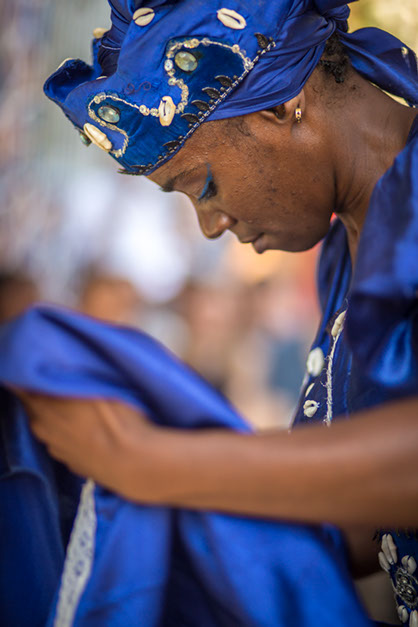
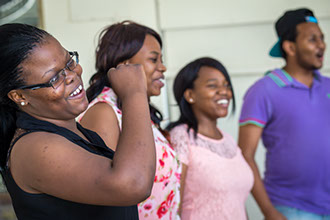
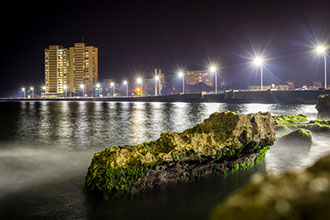
Matanzas, Varadero, and the like.
The second to last day of our time in Cuba saw the group getting up a little bit earlier than usual to head for Varadero, the tourist center of Cuba. Along the way we stopped in Matanzas, an hour and a half into the drive, to visit a publishing house and a ceramics studio. The publishing house was interesting, they provide jobs to people who are otherwise unable to work due to a physical disability. For instance one man was blind, but through his work at the house he is able to feel like a useful part of society.
Secondly, we stopped at a ceramics studio where different craftsmen come together in one place to work on their projects. The space was given to them about 2 years ago, full of trash a debris, and missing a roof, and the majority of the second floor had caved in. They cleaned it all up, laid some corrugated steel over part of the roof to keep rain out, and began to fill the space with their work. Their work, by the way, is absolutely amazing to me. One of our guides said that if you want to know how Cuba feels, look at the art. Those feelings could not be any more clear. Pressure cookers, C-clamps, and heavy objects are common themes throughout many pieces. I stood looking at one in particular for at least 10 minutes. It was a sculpture of a man with a smile. But there was more. It was perched atop scaffolding, perhaps to show how the smiles and good vibes are brought to the forefront for visitors to Cuba. On his face were a bunch of clamps, one prominently stating, "Made In Cuba". The clamps were made to look like they were forcing the man to smile.
The whole trip I had been wondering to some extent if we were really seeing Cuba as it is, or if the guided experience was crowding out some of the realities of life for the locals. The art here answered my questions. People here are incredibly proud of what they have accomplished through socialism, but all is not perfect and they know that.
After the art, we drove to the top of a small hill and went inside an old church that now functions as a concert hall, and along the way nearly un-painted the right side of the bus with a telephone pole, but we survived. The view from the top, if you were willing to brave the shaky stairs, was great. Miles and miles of visibility, including the boatless Harbor, made for a good stopping point. We also learned some new dances. I'm not sure what they were, but they were some old style of thing with small programmed steps and folding paper fans that the women throw at the feet of men. It was weird, but the lunch that followed was the highlight. More rice and beans, now a staple, more chicken, also a staple, and fresh chocolate eclairs. After lunch we started the last hour long leg to Varadero.
Immediately upon crossing the control point to get into Varadero, which is necessary for them to make sure that Cubans who don’t work there can’t get in, things changed. Suddenly green, mowed lawns took over, the only ones I have seen in Cuba, gardening and birds of paradise were everywhere. The buildings were still a little tattered, Laufer said they were thread bare but that they tried to nail all the essentials of a resort in any other Caribbean country. We got to our hostel for the night and almost immediately everyone headed to the beach. The beach was beautiful and empty. Sapphire blue water, white sand, palm trees, it was great.
The only downside is that the sand was really hot and I made the mistake of taking off my sandals, so I lived with tender feet the rest of the day. While everyone else swam, I decided to explore a bit. If you’ve been to any tourist hotspot you already know what the streets lined with small booths with identical stuff for sale looks like. I went 20 blocks in one direction, 30 in the other, and didn’t find a single place that sold anything authentically produced by the people there which I was a little disappointed by.
I came back in time for dinner, which was, you guessed it, rice and beans, but this time it was with, no, it was chicken again. Don’t get me wrong, I love the rice, beans, and chicken, and I thought it was cool that even in the more touristy areas that they stick with the staples, of course the ration cards they live by don’t give them a lot of choice in that regard.
The night after that was described as the best night of some of our lives. We went to the beach, students only, and stood in a circle and gave our best go at a rap off the top of our minds. I’ve gotta say, I’ve never once rapped in my life, but I dare say I was not on the bottom of the list. We stood around, smoked cigars, I smoked a $22 Piramides Extra, the premiere Cohiba offering, but felt a little guilty about it considering that it cost more than what a Cuban working a government job would make in a month. Everyone decided to go back to the hostel, but since I was only half way through my cigar after an hour and a half, I decided to stay a while longer by myself. That moment, being there, alone, at the edge of Cuba, with a dark storm lighting up the skies in the distance, a cool breeze blowing, the perfect Cuban cigar, listening to nothing but the waves gently washing on the shoreline, might have been the highlight of my entire trip. It was a good 30-45 min in which I got to be alone and go over in my mind everything that had happened so far. If it had ended there, it would have been great, but there was still more to come.
The group came back down to the beach, and even though they had left me there alone, and didn’t see me up at the hostel, they didn’t realize it was still me sitting there. I played into it a bit and didn’t respond when they asked if it was me, which made it more fun to walk over a few minutes later and have a few of them get uncomfortable with my presence before I started talking. I joined in one more game of mafia after which we decided we needed to go find some music. The first place, which had a live DJ for the night, also had a $10 cover charge which none of us were willing to pay. We settled for a game of pool, just one game of pool, and then we left for the next spot. It was a club maybe 10 blocks away from where we were staying, absolutely packed with people, both Cuban and international alike. We met people from Holland and Canada, who stuck with us for the rest of the night, Fahmo and Lorin danced on stage with the club’s performers, and the rest of us danced outside, in the rain. It’s one of those moments you know you can never recreate in your life regardless of how badly you might want it. Sheets of warm caribbean rain, wind coming on like crazy, and here’s a group of Oregonians dancing outside in a lightning storm while everyone else hides under the roof to avoid it like the plague. Then they shut the power off. I guess the officials in Varadero do it whenever a large storm rolls through so that if any power lines or the like get taken down that it won’t cause further issues. It was only 5 minutes or so and then the club was alive once again and the dancing continued. Rainier, one of our guides, summed it up after we got back to the hostel saying that “sometimes the little kid inside of you just needs to get out and dance in the rain.” It’s a night that none of us will forget anytime soon, in fact I’m still dancing to it in my head right now.
- Jake Charlson


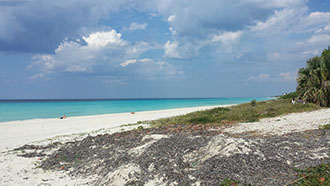
I woke up today to the chirping of eager birds, the rumbling of DIY carburetors, and the muffled voices of friendly neighbors. Andy, Casey and I decided to escape our air conditioned rooms and sleep under the stars last night. Something that Andy and I end up doing more than once. We all agree that sleeping outside on the terrace and falling asleep to the sounds of Marianao help us feel more present during our short visit to this amazing place. As usual, I am the first one awake. I get up to change my clothes with just enough time to sit outside and
reflect before the others wake up. I sit back against the stairwell of the MLK center and breathe, avoiding any thoughts that may interrupt my intake of this special moment. My mind is clear and my heart beats slowly as our adoptive community raises to take on another day. The rest of the group is awake now and we enjoy our breakfast of pineapple, bread, hard boiled eggs, and everyone’s favorite condiment, salsa picante. We are allotted free time for the morning to relax or explore. Naturally, the boys make a mad dash for the local park to join in on a game of futbol in the abandoned pool of what once was a thriving community hotspot. Getting to know the local kids and bonding over sports has been the highlight of the trip for
many of us. I join Kyle and Jake at the top of the stairs and we watch as the park next door fills with laughter, teasing, and games. We decide to join them. These kids are younger than the usual crowd that we often play soccer with. We try to join in on a game of volleyball, but it ends up being a series of dropped passes. We can tell they are eager to play, but may not know how. I ask 3 timid, giggling girls if they would like to play with me after handing each of
them a flower that I picked up in the walk over.
They agree to let me teach them an American game, and suddenly the size of the group doubles. I decide to teach them the first game that pops into my head; spider tag. I teach them the rules and they catch on quickly. After a few rounds of countdowns, freezing, and tagging one another with the ball, our group size has tripled and we are in need of a new game. Kyle joins me and we decide to teach them how to play Tiburones y Peces Pequeños , Sharks and Minnows. Kyle’s a natural, so we split up and explain the rules in Spanish as best as we can.
They seem to understand, so we start. Kyle says, “listos peces?”, and the whole park is filled with a unanimous “Si!” We begin and the game of tag brings laughter to the kids and an uncontrollable smile to our faces; they love it. We play a few rounds, but before we know it, our time is up. The kids have to return to school, and it’s time for us to start our day. We are sad to leave but hopeful that we have just introduced a game that they will teach their friends and continue to play for years to come. We walk back to the MLK center planning our return to Cuba. We agree that our first stop will be to come back to Marianao.
- Lorin Anderberg


Today seemed different. Or maybe it was myself who felt different. I intentionally did not bring my camera with me because I wanted to be present “in” Cuba and experience and live the day as any other Cubans would.
The places we visited were perfect for this new experiment without camera thing. Lots of sightseeing, music, cultural events were happening everywhere. I would be lying if I said I didn’t have, “Ah, I should’ve brought my camera with me” moments. But when I stepped onto the rooftop of the Lonja Del Comercio De La Habana, I had the ah-ha moment.
It was such peaceful moment to overlook the traffic, the square and people walking around… I felt as though I was finally emerged into this whole Cuba thing. I didn’t feel like an observer or an outsider. Even though I was still observing, the fact that I wasn’t trying to capture the moment, but rather trying to live it and be present in it, changed a lot for me. This moment helped me pace myself for the rest of the day as well as rest of the time we had in Cuba.
We had such limited amount of time in Cuba. My ambition for the trip was immense. I was, if I may, a little disappointed that we weren’t granted with much journalistic opportunity and experience than we expected. But when I looked down at the view of St. Francis sq. I realized how rare this moment was. Everything that was happening around me, or rather below me, wasn’t something that I would witness again anytime soon.
Also, the private concert we were given by the pianist was incredible. With my own senses, not depending on any other device, I truly enjoyed the moment. It was also inspiring to watch those talented artists perform. I don’t know the exact condition of their education and training, but the way they performed didn’t make me care what kind of instruments they had or didn’t. I believe it was their passion and love for the music that made who they are as the artists.
Overall, what struck me the most today and throughout the trip so far is how happy people are. Whether people have a little or more in their lives, they seem to be content with their lives. They are always curious about others, want to talk to and interact with others, quite unlike what I was used to in the States. It was not only refreshing, but also a great reminder to myself that I should be more thankful, nicer to others, and be more involved in the lives of people around me.
- Sumi Kim
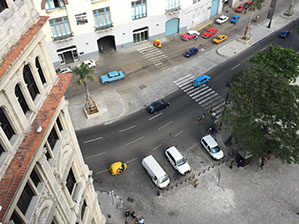
As I woke up Saturday morning, I began to collect my thoughts on the night that was. Getting caught in a torrential downpour, accompanied by violent thunder, then trying to find cover in a Varadero nightclub was something I was never going to forget. I struggled to get out of bed, as the wall-to-wall days were finally catching up to me. I had woken up a little later than the rest of the group, as it appeared most had finished their breakfast. Nevertheless, I was handed an egg flat, and a cup of that addictive and delicious Cubano coffee I had been drinking all week. After dousing my egg in the American taste of Tabasco, I downed my protein.
My plate was cleared, and I brought my coffee over to a patio where I could put my feet up and take in the beach town one more time. We were notified that we had until noon to explore, then we were to have lunch and a group reflection of the week. I began to pack my things and determine how I would spend the rest of my morning. I had heard that Casey was going to get a tattoo around the corner from where we were staying, so I decided to go see how a Cuban tattoo artist performs their work. As Casey stood by for his turn, I stepped in to a barbershop next door.
There was a woman getting her nails done in the corner, and a gentlemen sitting in a barber chair looking for his next customer. Cuba had so far driven me to become a more spontaneous person, so I thought, why not get a haircut in Cuba? With the little Spanish I knew, and the broken English the barber responded with, I had him cut the majority of my long, exhausted looking hair off. As he brushed the last hairs off my neck, I looked into the mirror and knew that my new spontaneous self had paid off.
I headed back over to the tattoo parlor to watch Casey get his tattoo. Once he finished, we dashed back to get our lunch and wrap up the week. Everyone spoke about the highs and lows of the week, said our thank you’s, and filled out evaluations from the abroad program. We then loaded onto the bus, and said our final goodbyes to Varadero.
After the 2-hour bus ride back to Havana, we quickly dropped off our gear at the MLK center, and re-boarded the bus back to Central Havana. Our last evening exploration was at the Hotel Nacional, a beautiful building with views overlooking the Malecon and Havana Bay. I explored the grounds, and then found myself helping Fahmo shoot a news segment for the SOJC. With the beautiful city lights and antique cars in the background, the segment looked magical.
As we wrapped up our tour of the Hotel, we took a short bus ride to the El Vedado neighborhood and sat down for one final Cuban dinner at a popular paladar. I sipped on my Cuban cola, and devoured my grilled chicken and of course the always-delicious Cuban rice and beans. We boarded the bus, and said our final goodbye to downtown Havana as we headed towards the MLK center.
I got to my room, packed my things for the long day of travel ahead, and got into bed. What a night. What a day. What a week.
- Zach Blaine
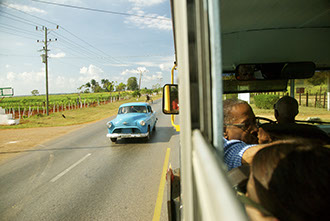
Why not capture images of Havana and Cuba fifty years after the revolution and the embargo just as Washington and [Raúl] Castro begin to normalize official relations with my first camera and a camera of the era for journalists: the Pentax Spotmatic.
Most images of Havana – from the Lonely Planet guidebook cover to the jacket for the Buena Vista Social Club CD – are so Technicolor they’re almost Cuba cliché with their saturated richness. I chose to look at the place as most news photographers did in the early 1960s, via black and white Kodak Tri X.
I hypothesized that using the mechanical Spotmatic instead of a glitzy digital camera or an intrusive iPhone or iPad could make it easier for me to collapse the distance between me and my subjects. I may seem less the arrogant Yankee. The camera is a throwback to the pre-Castro era (just as are the iconic 1950s and early 1960s automobiles that famously still fill Cuban streets). Perhaps it will appear intriguingly familiar, or at least a curiosity – a conversation starter. And the fact that I cannot look down at a screen and immediately see the image (and show the image) should encourage relationship building with the subject even if it is only for an eye-catching moment.
I buy the overpriced relic film ($7.45 for just 24 exposures) and walk out of an Oregon camera shop bemused and strangely satisfied, shaking the yellow box and enjoying the old familiar sound of the canister rattling in the box. At my regular café, I buy a Pellegrino and place the Pentax and the Tri X on the table, looking forward to loading it.
I shake the box again and enjoy the comforting sound before I tear it open. I look at the plastic tube holding the film canister and remember it as a another relic. Those plastic containers (were they once cardboard?) littered our lives with valuable reuse options. Friends stashed their marijuana in them. Tiny hardware found a home in them. I snap off the top and shake out the film canister, the tail of film extending out through the felt that keeps the canister light tight.
I unscrew the camera from its leather case and heft the Spotmatic body and lens. It feels substantive in my hands, but not bulky. I set the ASA at 400. Mechanically. No screen. No menu. I pull up the rewind spool and with a refreshing mechanical snap, the back of the camera body opens revealing its back magic interior. In slips the film canister. I pull a couple of inches of 35mm film out, slide it over the covered backside of the lens and onto the wind reel spool, slipping the beveled end into the waiting reel slot. I crank the wind lever once and watch to make sure the end does not slip out of the slot. I push down the silver shutter button and listen to the reassuring Ka-Plunk of the mirror and shutter. I crank the lever and watch the film advance. I repeat the familiar action and see the film hold as the spool propels it around itself. Then I check to make sure the sprockets are properly aligned in the holes on both sides of the film strip. Time to close the back of the camera, light tight.
All is well. Next stop: Havana
- Peter Laufer
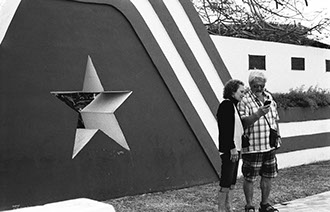
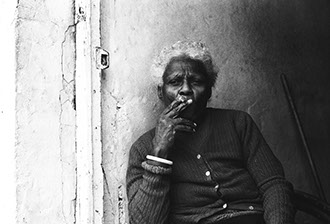
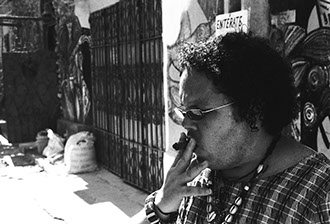
Viajar con Suerte, Trabajar con Fuerza,
y Jugar con Amor
We left Miami through a thin haze of smog, obscuring the not-so-distant island country we had all been dreaming of for the days. Now we were here, and as I stare out the window of a relatively small, turbulent airplane, I am consumed with an unyielding curiosity. Cuba: An alien neighbor to many people living in the United States, a mysterious neighbor vilified by years of propaganda and misinformation. Since President John F. Kennedy dramatically addressed the American people in 1962 the enigmatic country has transformed from a haven for Mafioso to a final bastion of a wildly different political philosophy to a success story in the fields of education, arts, and healthcare. All these stories had emerged from the lack of accessible information precipitated by America’s ban on travel and exchange.
Yet the 30-minute, 90-mile flight separating the two coastlines left me with little time to wonder whether the differences between our two countries were solely perceptions based on a lack of knowledge. Before the trip many people I questioned were surprised at how close our coasts were. I believe – scratch that, I wholly expect – that during this trip, I’ll experience a similar epiphany in discovering how close our cultures are and how mutually beneficial a newfound relationship could be.
I doubt there is an iron curtain to lift, a tyrannical oppressor to fight, an evil dictator to be deposed of by the great American freedom machine. Cuba, like every other country, has its problems. There may be poverty, there may be violence, and there may be prejudice. But the ‘evils’ of socialism and communism have not resulted in a country brought to its knees by a failed system of government. In the United States, one can still hear whispers of the Red Scare. Upon learning I would be traveling to Cuba, my grandmother gasped and her worrisome maternal instincts kicked into high gear, while my grandfather grumbled of the perceived ills of a failed, radically dangerous neighbor. This generational misunderstanding is based on perception, and that perception has been dominated by two systems with many ulterior motives.
It is time for that perception to change; I just hope that we can be a positive part of that change. I hope we can aptly apply the expensive education and technology we covet and craft a story that reflects the true nature of the people and the place we will inhabit this coming week. There is a lot changing between the United States and Cuba, and after President Barack Obama’s December 17th announcement of the reopening of relations between the countries, momentum could not be moving at a more relentless pace.
I hope we can bring back more than the rum, cigars and coffee that these new diplomatic arrangements have made legal in the US. I hope we can do more than snap photos of an exotic locale, only to look back on those photos and wonder at the differences. I hope we will bring back more than that. I know we will bring back a longing to know more, to learn more, to experience more, to share more, and to accept perspectives that have been all but locked away from our American zeitgeist. As journalists, as educators, as students, and as humans of this new, better world, it is our responsibility to bring back more. Luckily for us, we also have the wherewithal and wit to bring it back and share it with even more people. Staring at countryside pockmarked by burning fields and antiquated rail cars, I hope I can fight the willful ignorance that has dominated relations between our countries and I know that I’m ready to dive in.
- Casey Minter
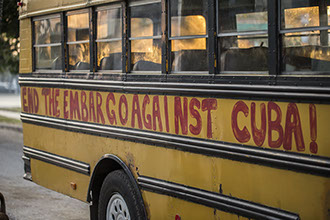

Today we visited an Afro-Cuban community. Our guide gave us a tour of the neighborhood and a very detailed description of African presence in Cuba and about the Afro-Cuban religions. A majority of those religions have roots in Nigeria and Benin. As we were walking through the neighborhood I made my way towards the front of the group and asked several follow up questions.
I became very intrigued as our guide started discussing the role that race plays in Cuba. With African and Spanish influence, skin tones in Cuba cover the entire spectrum. We learned there are three categories of race in Cuba. The first being white which has roots from Spain, then black which has roots in Africa, and lastly mulatto which is a mix of Spanish and African. Our guide proceeded to tell me that if I lived in Cuba I would be considered mulatto, even though I identify as black. After having my interested sparked like a wild fire I made sure to stay at the front of the group to continue my conversation with the tour guide. I learned so much in my short time talking with him, but it was bittersweet because I knew I wouldn't remember everything we discussed. I learned a crucial lesson. It is important to carry a voice recorder with you in when you’re in the field.
While talking with our guide I became confused a few times because of some contradictions. First, he stated that racial prejudice is something fairly recent in Cuba, and that the country would not have been able to stay strong as long as it did if it were divided. He stated that African leaders lost their status and power due to past prejudices, which is why there are only a few statues of African leaders in Cuba. He implied that racial prejudice has existed in Cuba since it was colonized and during the slave trade. I was also alarmed by his claim that racial prejudice in Cuba was not systematic. This did not hold up when he mentioned that black Cubans typically did not hold any governmental or high status positions in Cuba, but mainly Cubans of Spanish descent did. He also stated that all Cubans are viewed as equal, yet blacks don’t have access to the same opportunities as fair skinned Cubans.
This whole concept of the Black/African identity in Cuba is something that I find very fascinating. Through my discussion our guide, I can tell that race relations in Cuba is not openly discussed. I plan to research it further.
-Juwan Wedderburn
Thursday began like most: groggy eyes at the breakfast table, composing myself only enough to piece together a breakfast sandwich of butter, ham, hardboiled eggs, and, for the extra kick I needed today, hot sauce.
Jordan, Reuben, Sutton, and I were profiling Lizbeth Peralta, the owner of a paladar, or privately owned restaurant. We had arranged to accompany Lizbeth on her morning trip to the market.
We arrived at the paladar to find only three seats available in Lizbeth’s car. Unsure whether or not this was the kind of third world country in which it is acceptable to fit as many people as necessary into a car, I decided let the trio go together, and spent the interim sitting with Hope, our translator, in the paladar’s garden.
An American, Hope has been living in Cuba for the past four years, and on and off for eight years prior to that.
“Wow. A real American in the real Havana,” I said. “How exotic life must be.”
“It’s nice,” she said. “But it’s really nothing special.”
We talked about traveling from the U.S. to Cuba, about her special access as a foreigner to the Internet, and about El Paqueta, a weekly thumb drive distributed across the country filled with media products from outside Cuba.
“El Paqueta comes in so many different configurations,” she said. “Many are general and contain a mix of music, movies, advertisements, magazines. And then you can find some as specific as Korean soap operas.”
The conversation shifted to the “blockade.” Though Americans are familiar with an embargo, Cubans consider it a blockade, exclaiming that America uses its clout to influence other countries’ trade with Cuba.
I have been under the impression that, overall, lifting the blockade would benefit all involved. But I’ve had the suspicion that such openness would wipe out whatever it is that made Cuba so special: peripheral in its proximity, so close — as Elvis appropriately sang — yet so far.
“So,” I asked. “Aren’t you afraid that lifting the embargo will lead to the ‘McDonald-ization’ of the country?”
“No, not really.”
What! An American, living in Cuba, not terrified of McDonalds?
“Well, then,” I said. “Are you afraid Cuban society will become one more interested in their smart phones than with each other?”
“That is already taking place.”
“Oh. Well, is there anything?”
“You know,” she said, pondering for a bit. “I think ending the embargo may really affect safety.”
“Safety,” a facet I had not previously considered.
“There very few people who have more than everybody else,” Hope said. “And nobody has much. So there’s little incentive to rob or steal. Lifting the embargo will probably increase inequality, and that may diminish the kind of safety we have now.”
Hope and I sat in the garden amid that agreeable Havana breeze for a short while more, sharing our travels, admiring the garden’s flora, and singing to Cody, the paladar’s resident talking bird.
I considered ditching my cohort and fleeing into the Sierra Maestras, a mountain range in Cuba’s southeast where the natives once hid from the Spanish, and where Castro once hid from Batista.
The trio returned to the paladar before I had any time to act.
- Kevin Mataraci
We got into Havana yesterday. As it was with most new places, my preconceived vision of how I thought it was going to look vanished almost immediately. I still can’t comprehend everything around me.
The night before our flight, while seven of us were piled into one Miami hotel room, I had an extremely vivid and realistic dream that I lost my teeth. The Freud in me guessed that it signified a fear that I wouldn’t be able to communicate with my semi-conversational Spanish. Here, on day two, I’ve found that’s somewhat true, but there’s something more to it.
While walking through the streets of Old Havana as well as listening to our two speakers today, one a member of the Cuban government and another a Cuban economist, I felt overwhelmed. Culture shock isn’t the right word for it, but my mind is working overtime to consolidate the relationship between this country and my own, between socialism and capitalism. This sort of drastic inward reflection isn’t usual for me when traveling, and I don’t think I was expecting these to collide so violently.
We heard from Reverend Raúl Suárez, the director of The Martin Luther King Center (where we’re staying) and member of the National Assembly of People’s Power (Cuba’s legislative branch). He was the shortest man in the room, but I don’t know if many noticed. He spoke with conviction as his silver watch loosely slid up and down his wrinkled arms. As a man who has seen Cuba pre and post-revolution, we listened to his take on Cuban history and how it affects where the country is headed. He spoke about how capitalism is an ideology like any other, including Christianity.
We also spoke with a Cuban economist. We had a long conversation with her, talking about how they continue to approach economics from a socialist philosophy. “A greedy person—it doesn’t matter where it lives.”
In the evening, out on the streets of Old Havana, we walked down alleys, the tourist promenade. Hugged by the Spanish colonial architecture, we stared Cuba right in the face. We are here. There were street-level apartments, families filled in places where storefronts would be in a capitalist city. Other open doors had beckoning staircases and dark, maze-like hallways. We walked into the touristy Floridita bar, a favorite of Ernest Hemingway’s. Right outside was a six-foot deep and wide pothole exposing a water pipe without any caution tape. We took the elevator up to the luxurious Hotel NH Parque Central and enjoyed the view, live music, and sitting by the rooftop pool. Next door was equally sized vacant building covered in old scaffolding and tattered drapes. People had a smile for us, but there was an emotional undercurrent. I’m not sure what it was.
Hopefully I’ll settle in and get my teeth back. Hopefully I’ll be able to empty my mind a little and embrace a new perspective. I shouldn’t be too hard on myself: the Cold War was fought over this stuff.
- Michael McGovern
